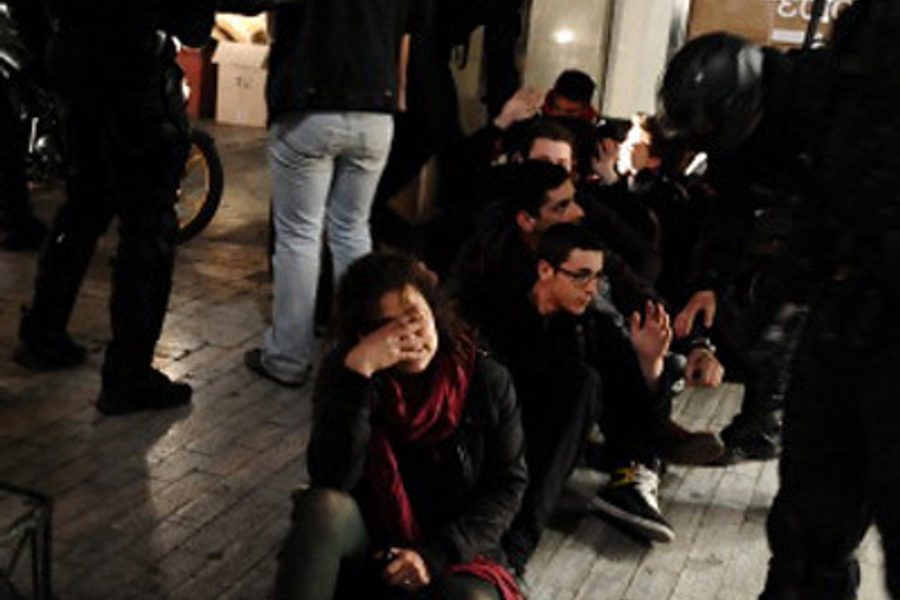
The metaphor of suicide has been used to depict the downward spiral surrounding countries bludgeoned by the economic crisis — particularly U.S. and Eurozone communities plagued by epidemic joblessness and a rash of budget cuts. Now the term literally describes the psychological dimension of the crisis, according to studies on suicide rates.
Some symptoms of the social despair have been grimly spectacular. Greece was jolted one recent morning after aging pensioner Dimitris Christoulas put a pistol to his head in Athens’s main square. In 2010 Americans were shaken by the suicide-by-plane of Andrew Stack, whose anger at the political establishment propelled him into an Austin office complex. Poorer regions have flared with public self-immolations, particularly in the communities of the “Arab Spring” where many youth come to see life as a dead-end street. Underlying these more dramatic examples are statistical patterns that reflect society’s unraveling.
A recently published Lancet study showed spikes in suicide across Europe during the recession. While many factors could contribute to this pattern, researchers found a significant correlation between unemployment and suicide trends.
The BBC summarized:
During the period, there was a rise in unemployment by a third.
Only Austria saw suicide rates fall. This was put down to the country being less exposed to the financial crisis than the others.
Of the risers, Finland fared best while Greece had the worst record. The UK saw a rise of 10% to 6.75 suicides per 100,000 people.
Dr David Stuckler, one of the researchers, said: “There was a complete turnaround. Suicides were falling before the recession, then started rising in nearly all European countries studied. Almost certainly these rises are linked to the financial crisis.”
And he added it was also possible there would be other health consequences from the economic problems as the impact on heart disease and cancer rates was not likely to be seen for many years.
In a way, such studies confirm the obvious: as life gets harder, people beset by hopelessness begin to question whether it’s worth it. Still, the data underscores the senselessness of a crisis fueled by the gambling of financiers – high on irrational exuberance and a sense of corporate invincibility – with such grave potential consequences for ordinary people, far from Wall Street, who essentially played by the rules. The lethal impacts speak to the malaise rotting society’s political and economic organs. Suicide starts to seem a strangely rational measure of life’s cheapness in a monetized society – people’s logical response to a loss of control over their destinies.
Or, as Christoulas put it before ending his misery:
I see no other solution than this dignified end to my life, so I don’t find myself fishing through garbage cans for my sustenance. I believe that young people with no future, will one day take up arms and hang the traitors of this country at Syntagma square, just like the Italians did to Mussolini in 1945.
Economic trauma has subtler long-term effects, too, according to the International Social Security Association:
A survey documented in the 2010 World of Work Report published by the International Institute for Labour Studies suggests that the crisis has induced an unprecedented global decline in life satisfaction. In concrete terms this has translated into greater pessimism about the quality of life, diminished confidence in the ability of governments to shape brighter and fairer futures, and greater social unrest among other things.
Data from the U.S. may not be as dramatic as the emblematic image of the Wall Street broker defenestrating himself in the era of the Great Depression. But in the dawn of the Great Recession in 2009, the Wall Street Journal reported on bleak suicide patterns:
The data from 19 states find an increase in suicides in the recessionary year of 2008 from 2007. Those states historically account for about half of annual suicides in the U.S. Calls to suicide hotlines are rising.
Another long-term study focused on New York City revealed links between economic volatility and suicide. According to researchers with Columbia University, “the monthly suicide rate in New York City from 1990 to 2006 was 29% higher at the economic low point in 1992 than at the peak of economic growth in 2000.”
Researcher Dr. Sandro Galea told In These Times that although “it is always difficult to extrapolate from any one study” to project future trends, “this study is consistent with others that suggest, yes, that economically challenging times are associated with greater risk of suicides. This work strongly suggests that, in these times of economic downtur,n a wise approach is to invest, rather than to disinvest, in health resources that can mitigate some of the consequences of the economic downturn.”
But ironically, self-destructive tendencies afflict governments as well. Research on the crisis in Greece indicates that budget slashing, though often touted as fiscal therapy, actually deepens the malaise as healthcare access dries up: “there were about 40 per cent cuts in hospital budgets, understaffing, reported occasional shortages of medical supplies, and bribes given to medical staff to jump queues in overstretched hospitals.”
The New York City researchers reported that the trends were somewhat difficult to assess due to “Another complicating factor: some investors profit as the market tumbles.” The ripple effects of economic turmoil may be muddled by the twisted benefits scored by those who happened to be on the right side of the trading floor. So the market once again finds its equilibrium point.
The statistics reveal the unnerving question underlying our collective struggle to make sense of systemic tragedy: Who really pulls the trigger?
Michelle Chen is a contributing writer at In These Times and The Nation, a contributing editor at Dissent and a co-producer of the “Belabored” podcast. She studies history at the CUNY Graduate Center. She tweets at @meeshellchen.








